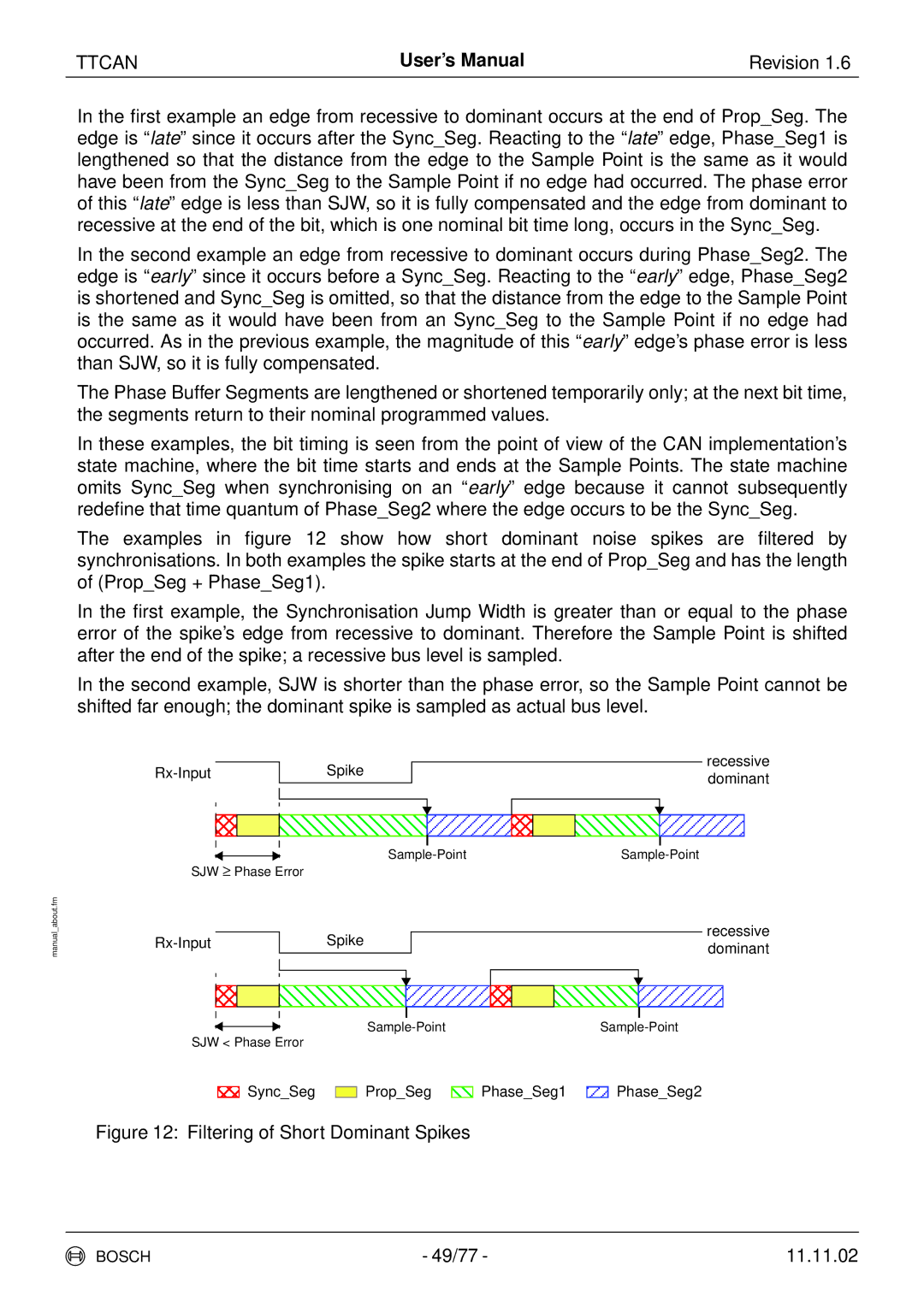
TTCAN | User’s Manual | Revision 1.6 |
In the first example an edge from recessive to dominant occurs at the end of Prop_Seg. The edge is “late” since it occurs after the Sync_Seg. Reacting to the “late” edge, Phase_Seg1 is lengthened so that the distance from the edge to the Sample Point is the same as it would have been from the Sync_Seg to the Sample Point if no edge had occurred. The phase error of this “late” edge is less than SJW, so it is fully compensated and the edge from dominant to recessive at the end of the bit, which is one nominal bit time long, occurs in the Sync_Seg.
In the second example an edge from recessive to dominant occurs during Phase_Seg2. The edge is “early” since it occurs before a Sync_Seg. Reacting to the “early” edge, Phase_Seg2 is shortened and Sync_Seg is omitted, so that the distance from the edge to the Sample Point is the same as it would have been from an Sync_Seg to the Sample Point if no edge had occurred. As in the previous example, the magnitude of this “early” edge’s phase error is less than SJW, so it is fully compensated.
The Phase Buffer Segments are lengthened or shortened temporarily only; at the next bit time, the segments return to their nominal programmed values.
In these examples, the bit timing is seen from the point of view of the CAN implementation’s state machine, where the bit time starts and ends at the Sample Points. The state machine omits Sync_Seg when synchronising on an “early” edge because it cannot subsequently redefine that time quantum of Phase_Seg2 where the edge occurs to be the Sync_Seg.
The examples in figure 12 show how short dominant noise spikes are filtered by synchronisations. In both examples the spike starts at the end of Prop_Seg and has the length of (Prop_Seg + Phase_Seg1).
In the first example, the Synchronisation Jump Width is greater than or equal to the phase error of the spike’s edge from recessive to dominant. Therefore the Sample Point is shifted after the end of the spike; a recessive bus level is sampled.
In the second example, SJW is shorter than the phase error, so the Sample Point cannot be shifted far enough; the dominant spike is sampled as actual bus level.
manual_about.fm
|
| Spike |
|
|
|
|
|
| recessive | ||
|
|
|
|
|
|
|
| ||||
|
|
|
|
|
|
|
| dominant | |||
|
|
|
|
|
|
|
|
|
| ||
|
|
|
|
|
|
|
|
|
|
|
|
|
|
|
|
|
|
|
|
|
|
|
|
|
|
|
|
|
|
|
|
|
|
|
|
|
|
|
|
|
|
|
|
|
|
|
|
|
|
|
|
|
|
|
|
|
|
|
|
|
|
|
|
|
|
|
|
|
|
|
|
|
|
|
|
|
|
|
| |||||||
SJW ≥ Phase Error |
|
| ||||||||||||
|
|
|
|
|
|
|
|
| ||||||
|
|
|
|
|
| Spike |
|
|
|
|
| recessive | ||
|
|
|
|
|
| |||||||||
|
|
|
|
|
| dominant | ||||||||
|
|
|
|
|
|
|
|
|
|
|
|
| ||
|
|
|
|
|
|
|
|
|
|
|
|
|
|
|
|
|
|
|
|
|
|
|
|
|
|
|
|
|
|
|
|
|
|
|
|
|
|
|
|
|
|
|
|
|
|
|
|
|
|
|
|
|
|
|
|
|
|
|
|
|
|
|
|
|
|
|
|
|
|
|
|
|
|
|
|
|
|
|
|
|
|
| |||
SJW < Phase Error |
|
|
| |||||||
|
|
|
|
|
| |||||
|
|
| Sync_Seg |
| Prop_Seg |
| Phase_Seg1 |
| Phase_Seg2 | |
|
|
| ||||||||
|
|
|
|
|
| |||||
Figure 12: Filtering of Short Dominant Spikes
BOSCH | - 49/77 - | 11.11.02 |
